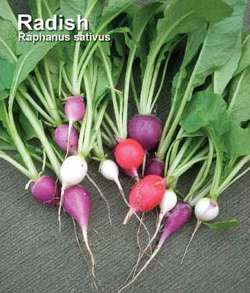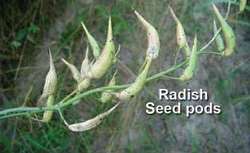radish
radish
radish
[′rad·ish]Radish
(Raphanus sativus), a vegetable plant of the family Cruciferae. There are annual varieties (European varieties), which form roots and seeds in the year in which they are planted, and biennial varieties (Chinese, Japanese, and winter varieties), which form roots in the first year and seeds in the second year. In the USSR, the European varieties are most commonly cultivated. The leaves are strongly or only slightly dissected; in the Chinese varieties they are sometimes entire. Most of the European varieties have small roots (7–20 g), which range in shape from round-flat to elongate-cylindrical. The roots are red, pink, white, violet, or yellow. The vitamin C content is 25–30 mg percent in the roots and 50–60 mg percent in the leaves. The roots are usually eaten fresh in salads, as are the young leaves of the slightly pubescent varieties. The flowers, which are white, pink, or lilac, bloom 50 to 70 days after planting. The fruits are indehiscent siliques measuring 2.5–7.5 cm in length.
Radishes are cold resistant and cross-pollinating. At temperatures greater than 20°C they bolt and do not form roots. The best soils for growing radishes are friable sandy loams with a large amount of organic matter and a weakly acidic or neutral pH. The plants are cultivated in greenhouses (planted after January 20; harvest within 45 days), in hotbeds, and in heated or open soil. In the USSR the best varieties are Zaria, Iygeva 169, Teplichnyi, and Rannii Krasnyi for protected soil and Zaria, Rozovo-Krasnyi, Novinka 515, and Krasnyi Velikan for open soil. The average yield is 20 bunches per sq m in protected soil and 60,000 bunches per hectare in open soil.
N. A. NIKONOVA

